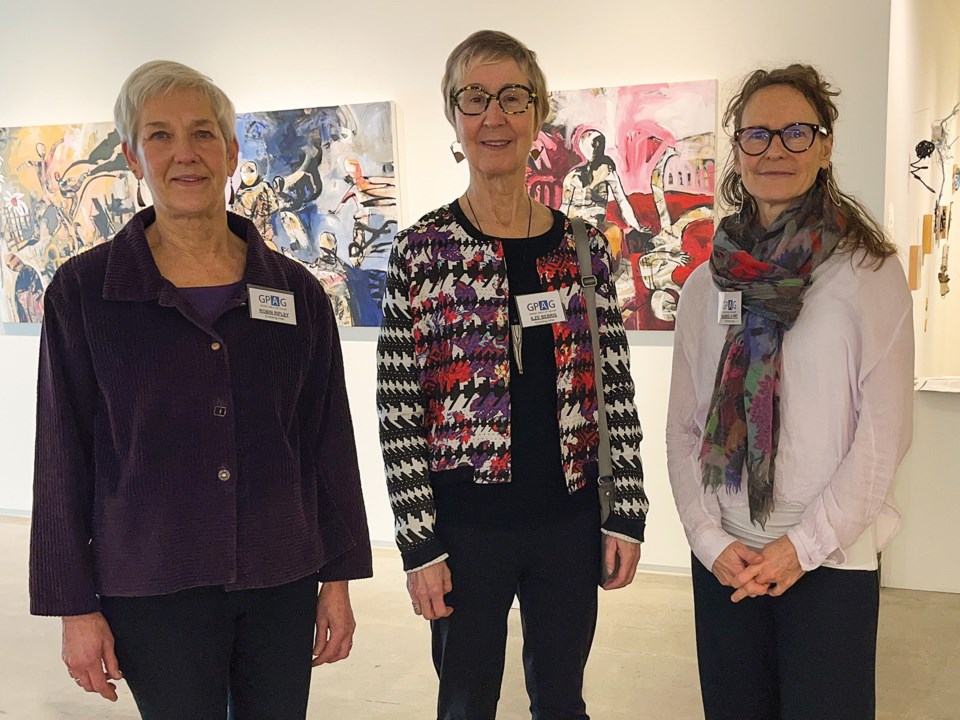A pair of concurrent exhibitions at the Gibsons Public Art Gallery opened last week, respectively exploring long-lasting hurts inflicted by history — and meaningful dialogue as a possible antidote.
More than three dozen visitors gathered on Jan. 14 during a public reception for the three contributing artists. GPAG president Leslie Thomson introduced Gabriela Hirt, creator of Storied Bodies, and Robin Ripley and Ilze Bebris, who collaborated to produce A Conversation.
Hirt, a Victoria-based expressionist, explores the effects of human trauma through florid abstracts and papier-mâché sculptures. She emigrated from Germany 20 years ago, a country where the shadow of the Holocaust exposed her to the enduring legacies of agony.
“I grew up in a society where we were coming to terms with the terrible things that happened [during the Second World War],” Hirt said. “When I started this work, I wondered what unknown stereotypes are living inside of me from my ancestors who lived through the Third Reich, and now of course here being a white settler on First Nations territory.”
Hirt, a former journalist, begins her artistic process using words to express her vision through private prose. She defines a strict colour palette, then starts making marks on canvases with acrylic paint and wax crayon. In the case of Storied Bodies, the shapes of human figures emerged, bowed and contorted by oppression. In works like In The Livingroom, they recede into the distance, forming a multilayered landscape of affliction.
Yet in paintings like You Me Them Us, and the suspended papier-mâché sculpture that gives her exhibition its name, the human form expresses resistance and endurance. Bent by unseen subjugation, abstracted figures extend their arms in expressions of despondency — and compassion.
“Often there’s a dialogue,” Hirt observed. “You know, [the image of] one person might evolve, asking for another person in conversation, in dialogue. You open one door, you go through, and then the next door opens and the story emerges.”
Conversation is also the subject of a bricolage exhibition by Robin Ripley and Ilze Bebris, two Vancouver-area artists. In collages by Bebris and assemblages of found objects by Ripley, the pair composed a graphic grammar that mimics the staccato nature of language-based communication.
“There’s a certain rhythm in conversation,” said Bebris. “Someone speaks, someone listens. Sometimes rhythm increases, sometimes it slows down. That’s why you’ll see little bits and pieces that suggest punctuation marks, gaps and pauses in a conversation that is otherwise static — in the sense that it’s mounted on a wall — like the written word.”
A pair of mismatched, three-dimensional parentheses enclose panels affixed with the ephemera of modern life: metal grilles, house numbers, a sneaker sole. Their titles reflect different modes of spoken exchange: Rhythm, Be Bop..., Freestyle #1.
“I sort of have the conceptual idea first and then kind of see objects that fit,” said Ripley, whose interest in linguistic cadences was honed during a career spent in libraries. She rarely buys the objects, usually finding them through happenstance or contributions from friends.
“These days, where dialogue seems to be lacking in society, I think artists can show the way,” Ripley said. “Artists are talking about society and the world at large, and they demonstrate the importance of being open to other people’s ideas and thoughts and dreams and hopes.”
Storied Bodies and A Conversation remain on display at the Gibsons Public Art Gallery until Feb. 5.



